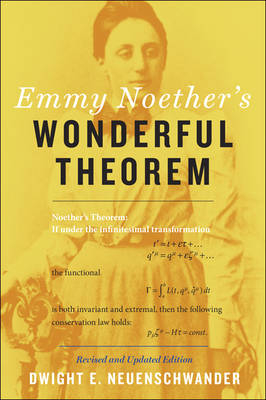
Emmy Noether's Wonderful Theorem
Johns Hopkins University Press (Verlag)
9781421422671 (ISBN)
In continuum mechanics and field theories, these conservation laws are expressed as equations of continuity. The second theorem, an extension of the first, allows transformations with local gauge invariance, and the equations of continuity acquire the covariant derivative characteristic of coupled matter-field systems. General relativity, it turns out, exhibits local gauge invariance. Noether's theorem also laid the foundation for later generations to apply local gauge invariance to theories of elementary particle interactions. In Dwight E. Neuenschwander's new edition of Emmy Noether's Wonderful Theorem, readers will encounter an updated explanation of Noether's "first" theorem. The discussion of local gauge invariance has been expanded into a detailed presentation of the motivation, proof, and applications of the "second" theorem, including Noether's resolution of concerns about general relativity. Other refinements in the new edition include an enlarged biography of Emmy Noether's life and work, parallels drawn between the present approach and Noether's original 1918 paper, and a summary of the logic behind Noether's theorem.
Dwight E. Neuenschwander is a professor of physics at Southern Nazarene University. He is a columnist for the Observer, the magazine of the Society for Physics Students, and the author of Tensor Calculus for Physics: A Concise Guide.
Preface
Acknowledgments
Questions
Part I. When Functionals Are External
1. Symmetry
1.1. Symmetry, Invariances, and Conservation Laws
1.2. Meet Emmy Noether
2. Functionals
2.1. Single-Integral Functionals
2.2. Formal Definition of a Functional
3. Extremals
3.1. The Euler-Lagrange Equation
3.2. Conservation Laws as Corollariesto the Euler-Lagrange Equation
3.3. On the Equivalence of Hamilton's Principleand Newton's Second Law
3.4. Where Do Functional Extremal PrinciplesCome From?
3.5. Why Kinetic Minus Potential Energy?
3.6. Extremals with External Constraints
Part II. When Functionals Are Invariant
4. Invariance
4.1. Formal Definition of Invariance
4.2. The Invariance Identity
4.3. A More Liberal Definition of Invariance
5. Emmy Noether's Elegant (First) Theorem
5.1. Invariance + Extremal = Noether's Theorem
5.2. Executive Summary of Noether's Theorem
5.3. "Extremal" or "Stationary"?
5.4. An Inverse Problem
5.5. Adiabatic Invariance in Noether's Theorem
Part III. The Invariance of Fields
6. Noether's Theorem and Fields
6.1. Multiple-Integral Functionals
6.2. Euler-Lagrange Equations for Fields
6.3. Canonical Momentum and the HamiltonianTensor for Fields
6.4. Equations of Continuity
6.5. The Invariance Identity for Fields
6.6. Noether's Theorem for Fields
6.7. Complex Fields
6.8. Global Gauge Transformations
7. Local Gauge Transformations of Fields
7.1. Local Gauge Invariance and Minimal Coupling
7.2. Electrodynamics as a Gauge Theory,Part 1
7.3. Pure Electrodynamics, Spacetime Invariances,and Conservation Laws
7.4. Electrodynamics as a Gauge Theory,Part 2
7.5. Local Gauge Invariance and Noether Currents
7.6. Internal Degrees of Freedom
7.7. Noether's Theorem and GaugedInternal Symmetries
8. Emmy Noether's Elegant (Second) Theorem
8.1. Two Noether Theorems
8.2. Noether's Second Theorem
8.3. Parametric Invariance
8.4. Free Fall in a Gravitational Field
8.5. The Gravitational Field Equations
8.6. The Functionals of General Relativity
8.7. Gauge Transformations on Spacetime
8.8. Noether's Resolution of an Enigma inGeneral Relativity
Part IV. Trans-Noether Invariance
9. Invariance in Phase Space
9.1. Phase Space
9.2. Hamilton's Principle in Phase Space
9.3. Noether's Theorem and Hamilton's Equations
9.4. Hamilton-Jacobi Theory
10. The Action as a Generator
10.1. Conservation of Probabilityand Continuous Transformations
10.2. The Poetry of Nature
Appendixes
A. Scalars, Vectors, and Tensors
B. Special Relativity
C. Equations of Motion in Quantum Mechanics
D. Conjugate Variables and Legendre Transformations
E. The Jacobian
F. The Covariant Derivative
Bibliography
Index
| Erscheinungsdatum | 05.05.2017 |
|---|---|
| Zusatzinfo | 15 Line drawings, black and white; 5 Illustrations, black and white |
| Verlagsort | Baltimore, MD |
| Sprache | englisch |
| Maße | 152 x 229 mm |
| Gewicht | 454 g |
| Themenwelt | Mathematik / Informatik ► Mathematik ► Analysis |
| Mathematik / Informatik ► Mathematik ► Geschichte der Mathematik | |
| Naturwissenschaften ► Physik / Astronomie | |
| ISBN-13 | 9781421422671 / 9781421422671 |
| Zustand | Neuware |
| Informationen gemäß Produktsicherheitsverordnung (GPSR) | |
| Haben Sie eine Frage zum Produkt? |
aus dem Bereich


